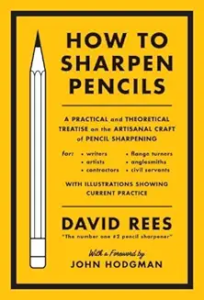How to Sharpen Pencils: A Practical and Theoretical Treatise on the Artisanal Craft of Pencil Sharpening by David Rees 2012
This book was recommended by Bill N who, having noted my pencil collection and my previous review of The Pencil, thought I would enjoy this one. Was he ever correct!
Rees is a cartoonist, a creator of podcasts and music and an general critic of today’s American culture. When this book was published, the New York Times called it “a methodical, deliberate and gleeful subversion and satire that capture[s] the inherently joyless tedium of conveying specialized instructional information, while tipping off the reader that the cod liver oil is laced with laughing gas. It noted “the book contains sections such as a list of common and uncommon children’s names, a comparison of the taste of certain wines versus the taste of certain pencils, and a guide to impressions of Sean Connery and Robert De Niro, but you can actually use the book to learn how to sharpen pencils.“
Though I found the book just a bit longer than necessary, I loved this it. I laughed out loud in many places, chuckled often, and smiled all the time while reading Rees’ tongue in cheek description of how to sharpen a pencil. Here’s an example of his crazy, subtle, and over the top humor as he discusses ‘novelty pencil-sharpening techniques’ which include “Sharpening a Pencil Behind your Back”. “Insert the pencil into the sharpener. Raise your arms over and behind your head. Don’t be alarmed if you can no longer see the pencil and sharpener; this is because they are behind you. Sharpen as usual , making sure the shavings don’t fall inside the back of your shirt.” These instructions, as most in the book, are accompanied by a photograph of Rees carrying them out.
A very funny introduction by John Hodgman concludes with this paragraph: “But even if you do not follow his precise instructions, apron-tying precepts, and eye-wear recommendations, David hopes, and I do, that you will at least see this: while a pencil is about accepting that there is error in life, a freshly sharpened pencil is about starting over, and never ceasing to hope for–and work for–the perfect point. While that perfection may never be attained, it is cowardly not to try. You might as well use a felt-tip marker.” Hodgman’s intro follows five pages of blurbs recommending the book, from people like Neil Gaiman, Amy Sedaris, Elizabeth Gilbert, Matt Taibi and three third graders.
The book is very funny, but it also turned out to be useful, as Hodgman suggested. On Rees’s recommendation, I have junked both of my electric pencil sharpeners (His chapter on how to sneak into people’s houses and destroy their electric pencil sharpeners is a complete hoot.) and bought a KUM/Palomino Long Point multi-hole sharpener at Bob Slate’s Stationer in the Square. I keep four sharpened pencils on my desk each day, and I will think of Rees every time I sharpen those Blackwing pencils, lovingly watching the mixture of graphite and cedar that curls inside the clear plastic case.
If you are depressed today because Congress is about to certify the election of donald trump, turn off the news, pick up this book, and sharpen your pencils. You’ll feel better.



